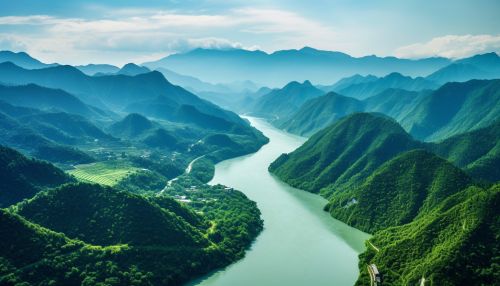Yangtze River
Geography
The Yangtze River, also known as the Chang Jiang, is the longest river in Asia and the third longest in the world, after the Nile and the Amazon River. Originating from the glaciers of the Qinghai-Tibet Plateau, the river flows eastward for approximately 6,300 kilometers before emptying into the East China Sea at Shanghai.


The Yangtze River basin, spanning an area of over 1.8 million square kilometers, is home to nearly one-third of China's population. The river's drainage area, which includes a diverse range of ecosystems, is rich in biodiversity and is one of the country's most important agricultural regions.
Hydrology
The Yangtze River's hydrology is complex, characterized by its long course, large discharge volume, and abundant sediment yield. The river's flow regime is influenced by the Monsoon climate, with the majority of its annual runoff occurring from June to September. The river's average discharge at its mouth is approximately 30,000 cubic meters per second, making it one of the world's largest rivers by discharge volume.
Geology
The geology of the Yangtze River is a testament to the dynamic nature of the Earth's crust. The river cuts through several of China's major physiographic regions, including the Qinghai-Tibet Plateau, the Sichuan Basin, the Yangtze Plain, and the coastal region of the East China Sea. The river's course has been shaped by tectonic activity, erosion, and sediment deposition, resulting in a diverse range of geological features.
Flora and Fauna
The Yangtze River basin is home to a rich diversity of flora and fauna. The river's ecosystems support numerous species of fish, birds, mammals, and plants, many of which are endemic to the region. Notable species include the Yangtze River Dolphin, the Chinese Alligator, and the Chinese Sturgeon, all of which are critically endangered.
Human History
The Yangtze River has played a crucial role in the development of Chinese civilization. Archaeological evidence suggests that the river's basin was one of the cradles of Chinese civilization, with human habitation dating back at least 20,000 years. The river has served as a major transportation route, a source of water and food, and a cultural and spiritual symbol throughout China's history.
Economic Importance
The Yangtze River is a vital artery of China's economy. The river's basin is a major agricultural region, producing a significant portion of China's grain, cotton, and oilseed crops. The river is also a crucial transportation route, supporting a large volume of inland waterway traffic. In recent decades, the river has been harnessed for hydroelectric power, most notably with the construction of the Three Gorges Dam.
Environmental Concerns
The Yangtze River faces numerous environmental challenges, including pollution, habitat loss, and the impacts of climate change. Industrial and agricultural activities in the river's basin have led to significant water pollution, threatening the health of the river's ecosystems and the people who depend on them. The construction of dams and other infrastructure projects have also had significant impacts on the river's natural flow regime and habitats.
